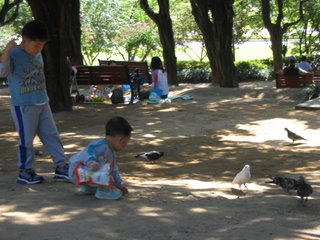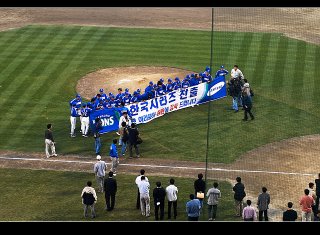Dear Friends and Family,
Korea is alarmed by its falling birthrate - one of the lowest birthrates in the world. I cannot recall where I first learned about this phenomenon but it has been mentioned to me several times by Koreans of my acquaintance and obviously preys upon the minds of many. I note this phenomenon for you all not just because it is interesting but because my experience in Daegu seems contrary - I see children, of all ages, everywhere. In baseball parks, crying in neighboring apartments, queuing for the school bus across the street, riding bikes, suspended upon their father’s chests, walking down bookshop stairs in rollerblades (!), begging Mom for a treat at E-Mart, giggling below my window, returning from classes dressed in gray uniforms, pushed in strollers by their grannies, and comprising the noisy majority on a City tour.
Having taught on Monday, I was on holiday for the remainder of the week so on Tuesday, while Korea celebrated the founding of its Kingdom, I boarded a tour bus to participate in a “Daegu City Tour.” According to the South Korean government, due to its geographically favorable conditions, important ancient sites, and beautiful scenery, Korea’s tourist industry has been growing by leaps and bounds in the past thirty years. The government has sponsored large projects to develop the industry including updating National Parks, improving accommodations, and beefing-up tourist services. These efforts are readily apparent in Daegu, which has a large tourist information center near Woobang Tower as well as several booths at handy sites such as the train station. I am particularly fond of these tourist centers because every time I visit, they press me into accepting another copy of the city map in English, which has been invaluable. The tourism authority that publishes city maps also runs bus tour services. Despite understanding that the tour would be all Korean all the time, I was eager to partake in a tour and expand my city knowledge.
When I emerged from the Subway to join the tour on that sunny Tuesday morning, I first spotted an unfamiliar Starbucks and then located the bus. Happy to have “discovered” another slice of home, I boarded the bus with a broad smile on my face. I greeted the Korean tour guide with a “good day” so proficient that she later told me that she thought that I spoke excellent Korean, paid 5,000 Won, and searched for a seat while noticing that the bus was filled with school-aged children. A kind Korean lady in an aisle seat stood up and ushered me into the window seat next to her. I pulled out my notebook and camera, smilingly refused a cup of coffee from my seat companion, and prepared for a day of learning.
Our bus pulled away from the curb, drove two blocks and then again parked. Seriously! Why bother? Anyway, the mothers and children and me filed from the bus, walked more three blocks and just as I realized that our first stop was the Daegu Herb Medicine Market, we entered a large traditional Korean building and found ourselves in an exhibition devoted to medicinals.

The plant and animal displays were rather fascinating. We were greeted by a smiling Korean tour guide, who gave a long and what I can only surmise was an informative, talk about Korean traditional medicines and the 350-year-old Daegu Yangnyeongsi Herb Medicine Market. The adults listened attentively to the guide while the kids raced around swatting and sword fighting with brochures. I politely trailed the tour through the various exhibits, reading English placards, spotting photographic opportunities, and taking notes. Fact: medicinal materials used in Korea at the end of the 16th Century numbered 1,403. 514 of the materials were types of animals, 143 were types of minerals, and the remaining 746 were composed of various plants. I wondered how today’s medicines stalked up in comparison. At the end of the tour, I sampled Ginseng candy (yum!) and found myself resolved to learn more about Korean herbs and history.

Next we retraced our steps but by-passed the bus and instead crossed an 8-laned city street and walked to an oddly-shaped brick building topped with a Korean portico. We were greeted by a Madonna statue and trooped down to the basement, were seated in wooden pews, and talked at by another Korean guide. Because this time the adults looked like they wanted to get up and sword fight with brochures, I suspected that this talk was less edifying than the last. However, the guide finally wound down and we were lead to a little museum featuring a picture of Pope John Paul II. It had only taken me 35 minutes to realize that we were in a Catholic church. Of course, the tour meaning continued to escape me so I slipped away with the kids to enjoy sunshine on upper deck Korean portico. Several kids literally rolled on a smooth wooden floor while I tipped my head back to note the usual Korean hand-paintings with unusual Jesus motifs.

Finally, we piled back into the bus and were driven more than a few blocks. As we approached our next destination, the shy daughter of the lady next to me asked in halting English if I’d join them for lunch. The lady forcefully reminded me of one of my aunts and picturing us all at a table in a restaurant where I could pay for myself, I assented. The bus disgorged us all on a street lined with restaurants and balloon stands and I followed the lady, her two daughters and her two nephews into a park. Uh… At the gate of the park, another lady, obviously a friend, met us with a bag in over her shoulder and we all trooped around the park until we found a picnic table under the trees. Then the two women unzipped their bags and pulled out an endless array of food. Ramen cups, sandwiches, snacks in crackly packages, rolls of picked veggie sushi, several kinds of fruit, coffee, water, cider, and the lady sent her nephew to buy some fried chicken. Talk about a feast! And there were other families enjoying the holiday’s weather with feasts of their own. I was grateful for the free lunch and wished that I could better convey my gratitude, especially as I had nothing to contribute. Although I must confess that the ladies seemed happy to have me, even if we were confined to exchanging smiles and hand gestures. We ate ‘til past full, enjoyed the park setting and eventually rejoined our tour group for a walk around the park that was also a zoo.
A “Rough Guide to Daegu” written for us EPIK teachers by a Brit who has been here for a few years advised that the “zoo [is] not advised if you are an animal lover.” I kept those words in mind as we strolled through the zoo with yet another guide, who lead us from monument to monument. At one point, the kind Korean lady bought the kids and me (!) a popsicle and I chomped on the popsicle, tuned out the guide, and enjoyed warm sun on my face. It amused me to watch all the proper Korean ladies scurrying for shade while I happily solicited freckles in the sun.
The kind Korean lady tried to ask me something that I simply did not understand on during our next bus ride to a Confucian Academy. She and I took a break from our efforts while we walked up to a building that turned out to be all that one imagines to be Korean: layered roof tiles ending in swooped points, symmetrical wooden structures that are austere even while colorfully painted. Although this building had an air of abandonment to it because there was a newish, modern facility of Confusion study around the corner. A modern building to study ancient ancestor worship boggled my mind, but I seemed the only one confused by this concept. Anyway, I then concentrated on more important things: apparently the kind Korean lady had been trying to ask if I would join her family in viewing a Special Exhibition during the final stop at the Daegu National Museum. Uh, yeah.

The National Museum was hosting a special exhibition titled “Treasures from Pyeongyang” and even before belligerent North Korea topped this week’s news, treasures from this “evil power” were intriguing. The exhibit brochure informed us that there were a “total of 90 items of North Korea’s finest cultural properties, including 50 National Treasures and 11 Treasures.” ?!? My favorite pieces were a huge bronze Buddhist bell (surprise!), an intricate gilded ornament with a three-footed raven design, some lovely celadon pottery, and regal seated king statue with a coordinating cloth draped across his privates. However, as intrigued as I was by the art, it was the exhibit signage that truly drew my notice.
As tightly controlled as information on North Korea is, it is well known that in order to remain securely power, the first Northern Korean leader, Kim, Il-Sung, created a cult of worship to, well, who better than(?), himself. I’ve read that statues and pictures of the original “Great Leader” are throughout the confusingly named Democratic People’s Republic and that for generations now, the government has taught that Kim Il-Sung was a genius having invented…well, everything. North Korea is a country whose every aspect is devoted to the Kim, Il(s) and South Korea is exquisitely sensitive to this fact. Anyway, despite poor quality English, the tone of this “Treasures from Pyeongyang” was pretentious to the point of propaganda regarding the greatness of the Northern leadership. I was surprised to be witnessing this attitude on South Korean soil. But the treasures were indeed memorable, perhaps an explanation unto itself regarding the signage.
We ended our trip to the museum in the gift shop and the kind Korean Lady’s daughter gifted me with a newly purchased tassel to commemorate the day. I was touched and again wished that I could adequately express my gratitude. During our return downtown, tired children and adults alike slouched in our seats. Upon disembarking from the bus, I exchanged names and phone numbers with the kind Korean lady and treated myself to Starbucks before wandering downtown to bargain an unsuspecting street vendor into selling me a travel backpack with a 15,000 Won discount. That night I packed for my purchase for an upcoming visit with a friend’s family for Korea’s version of Thanksgiving: Chuseok.
“When whales fight, it is the shrimp whose back gets broken.” A Korean Proverb that seems increasingly appropriate…
--Laura

















